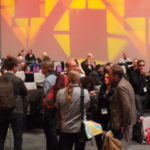
Members of the Manufacturers Association for Plastic Processors (MAPP) tend to be practical-minded, linear thinkers, according to Laurie Harbour, president and CEO of Harbour Results and a member of MAPP’s board of directors. In other words, despite the fact that they work for companies that make all manner of toys and games, they’re not a group you’d think would enthusiastically embrace the LEGO Serious Play program, in which conference participants explore their business challenges by building with LEGOs.
And yet there was Robert Rasmus-sen, a certified LEGO Serious Play facilitator who helped create the program when he worked for LEGO, leading a session at a recent MAPP Benchmarking Conference in Indianapolis — and people loved it. “[Rasmussen’s] exercise really got people who were very traditional thinkers in how they ran their manufacturing businesses,” Harbour said, “to open their minds a little bit more and think of different ways to process problems.”
In fact, one of the strengths of LEGO Serious Play is its hands-on literal-ness, asking participants to make the abstract concrete, one brick at a time. “There is the whole notion of what is called ‘constructionism,’” Rasmus-sen said in a Skype interview from his native Denmark, “in terms of how you build knowledge up here.” He tapped his temple. “We know that that process of constructing in here actually goes faster when you construct something physical, out in the physical world.”
LEGO Serious Play can be fitted to a variety of meeting types and goals, including board retreats, brainstorming sessions, and team-building activities. At a conference like MAPP’s, with about 350 attendee participants, Rasmussen will split people into groups of six to eight; each person gets a small LEGO kit with bricks in a variety of shapes and colors, and builds a model that answers a central question posed by the organizing group. In smaller programs, work proceeds to combining the individual models into one agreed-upon final model; in larger groups, the emphasis is on each person sharing his or her story, and then arranging the models into a “super story.”
“After four to five minutes, everybody has a model standing in front of them,” Rasmussen said. “And then you go around the table and everybody shares their story. And then based on what you learn, you reflect. That is the basic process: question, build, and typically give the LEGO models metaphorical meanings. If I build a rose, it would not really be a rose, right? It would maybe be a story about something that is beautiful or something that is sticky.”
At MAPP’s Benchmarking Conference, “each table was tasked with thinking about different things that are happening at their business today,” Harbour said, “and using LEGOs to depict what the problem was at their organization.”
The program left its mark — on Harbour and everyone else. “I see those guys a lot in [MAPP], and they still talk about the LEGO exercise,” Harbour said. “People were just so engaged, whereas usually people are falling asleep by the end of the day.”



